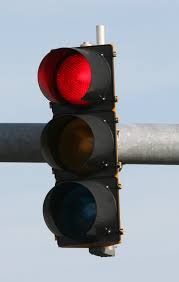Manteca may pursue a four-prong approach to combat red light.
That’s after the Manteca City Council spiked the possible use of camera technology that would cost as much as $250,000 per intersection to implement and would require the issuance of at least 200 tickets a month for the city to recover its costs. Instead they instructed staff to explore other steps the city could take to combat red light runners.
Those mentioned at last week’s City Council meeting include:
*Possibly lengthening the time of yellow lights or have all lights stay red for
a brief period if such adjustments are allowed by state law.
*Upgrading pavement markings at signalized intersections.
*Exploring equipping traffic officers with specialized equipment that allows the ability to more efficiently ticket red light runners by securing data that will hold up in court.
*Getting a long awaited updated citywide signal synchronization system put in place.
The council wanted the red light camera option explored after receiving numerous complaints from citizens about red light runners.
The bottom line with red light cameras if they are constantly checked to make sure they are operating correctly so that tickets issued with the driver being clearly identified will hold up in court the expense soon outstrips the revenue the city receives to offset their costs. That’s because after the red light cameras have been in place for several months and enough tickets issued, local drivers start paying attention more to red lights.
While that is good from a deterrence perspective, the city would find themselves saddled with an expense they couldn’t cover. Cities only receive $90 of every red light ticket issued.
Councilman Dave Breitenbucher referenced information that Loma Linda was able to reduce the incidence of red light running in their community by 90 percent by extending yellow lights by a second.
State law requires every 10 miles per hour of the posted speed entering into a signalized intersection to have a corresponding one second for the lights to be yellow. For a traffic signal on a street posted 40 mph that would call for a four second yellow light.
Mayor Ben Cantu believes it would make sense to have all sides of an intersection with a red signal for a brief period of time to avoid cars getting a green light from entering the intersection.
Manteca has roughly 55 intersections with traffic signals in addition to 10 sets of Caltrans controlled intersections on freeway off-ramps as well as two more sets on East Highway 120. The city has received a federal grant to improve traffic flow by modifying signals.
All of the city signals have older controllers that operate independently to direct both traffic and pedestrians. With new technology the possibility also exists to tie in the city’s systems with those operated by Caltrans to further enhance traffic flow.
New controllers will not only allow the city to sync traffic signals but they will create greater flexibility by being able to program them at a central location to take into account increases in traffic flow.
That means the city will be able to reduce congestion on corridors such as Main Street through downtown, East Yosemite Avenue between Button Avenue and Spreckels Avenue, and elsewhere in Manteca.
The technology is prevalent in cities of 200,000 or more residents but fairly rare for a city the size of Manteca.
Besides making traffic flow more efficient it will also reduce air pollution as idling cars pollute more than those that are moving.
To contact Dennis Wyatt, email dwyatt@mantecabulletin.com





